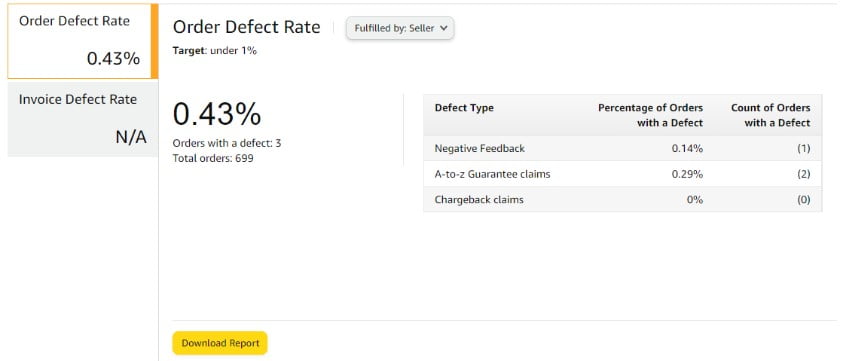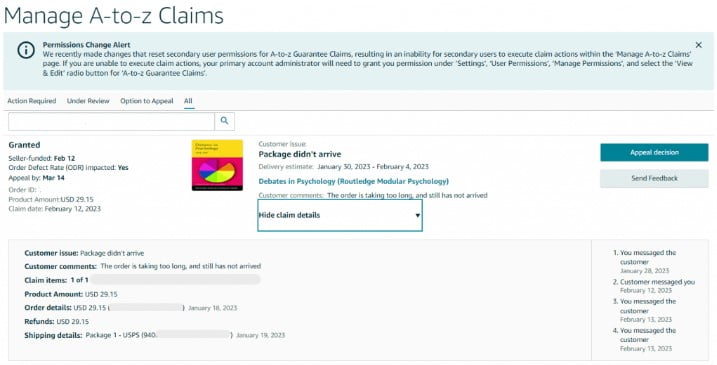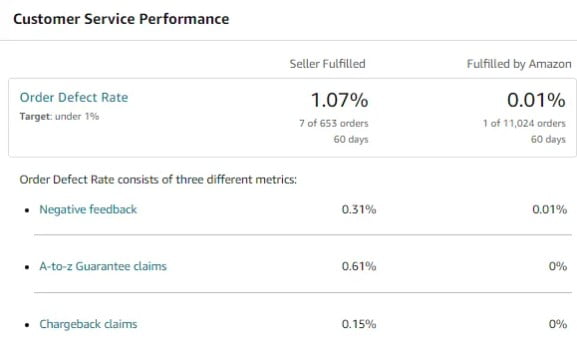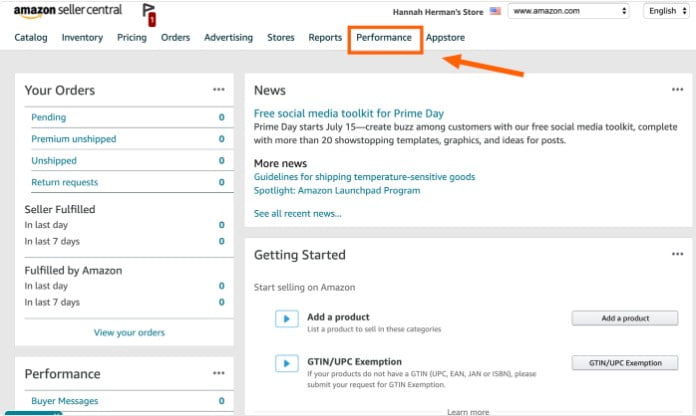As an Amazon Seller, you are expected to deliver top-notch products and optimize your storefront. However, there will be times when you will find yourself facing a rising tide of returns and customer complaints, which directly impacts your Order Defect Rate (ODR).
In this blog post, we will discuss the concept of ODR and provide you with practical strategies to enhance it and ensure your business remains on the path to success.








What is an Order Defect Rate on Amazon?
The Order Defect Rate (ODR) is a critical metric on Amazon, representing the proportion of customers who receive defective products within a specific time frame. Calculated by dividing the number of negative orders by the total number of orders during that period, ODR is a key indicator of seller performance. Amazon uses ODR to uphold exceptional customer service standards, ensuring a positive experience for its users.
What Makes an Order Defective?
An order is considered defective on Amazon based on three key components that contribute to the Order Defect Rate:1. A-to-Z Claims
These claims arise when customers are dissatisfied with their orders due to issues like late delivery or product conditions. Amazon’s A-to-Z guarantee allows customers to file claims for unsatisfactory experiences, and such claims can negatively impact your ODR.2. Negative Feedback
This includes unfavorable customer comments and ratings, reflecting a poor overall experience. Negative feedback can lead to higher ODR, which signifies subpar customer satisfaction.3. Credit Card Chargebacks
Customers requesting refunds for various reasons, such as poor service, fraud, damaged goods, or unresolved returns, can affect your ODR. Amazon calculates your ODR by considering these three factors and dividing the total number of instances by the total number of orders within a 60-day review period. For instance, if you had one A-to-Z claim and two negative feedback out of 100 orders in the most recent 60 days, your ODR would be 3%.How to Improve Order Defect Rate Amazon
Is your Amazon ODR showing signs of decline? Don’t worry; here are nine simple yet powerful strategies to enhance your ODR and maintain your competitive edge.1. Evaluate and Act on Customer Feedback
Carefully review all A-to-Z claims and customer feedback, which are the main factors influencing your rating. Identify recurring issues, such as late shipments or misunderstandings, and prioritize resolving them promptly to minimize their impact on your ODR.2. Prioritize Quick and Free Shipping
Timely deliveries prevent negative feedback. Whether you handle orders yourself or use third-party logistics, aim for accurate and fast order processing with reliable, on-time tracking updates. In cases of ODR-related suspensions, some sellers turn to FBA (Fulfillment by Amazon) for guaranteed compliance with Amazon’s standards and process, which can swiftly restore products to the Buy Box, even for a select few top-selling items, for a limited duration.3. Ensure Impeccable Product Packaging
Ensure your product packaging is both secure and of excellent quality. This precautionary step decreases the chances of shipping damage and ensures customers receive their orders in flawless condition. The result? Fewer complaints and increased customer satisfaction.4. Thoroughly Review Your Product Listing Page
To reduce your ODR, review your product listing page to align with Amazon’s guidelines and enhance customer satisfaction. Focus on the title’s accuracy, clear and professional images, detailed product descriptions, competitive pricing, and timely responses to customer reviews.5. Optimize Fulfillment Procedures for Peak Demand
During peak periods like the holidays, such as Christmas, it’s crucial to prevent late deliveries that can spike your ODR. Customize your order quantities to match demand and maintain a smooth fulfillment process. Consider using inventory management software for better tracking or utilize Amazon FBA to streamline the fulfillment process. Keep products arriving on time to safeguard your ODR.6. Time Management Matters
You’ve likely faced labor shortages and supply chain disruptions as an Amazon Seller. Consider ordering gifts and items with longer production times in advance to ensure availability for Black Friday and holiday sales. If you encounter inventory issues, promptly update your listings with accurate delivery times and stock status to minimize returns and refunds.7. Respond to Negative Feedback and A-to-Z Claims
Start by understanding the reasons behind these issues, which could range from order cancellations to late shipments or miscommunication. This presents an opportunity to resolve problems and potentially change customers’ opinions. Being attuned to your audience’s concerns allows you to improve the overall customer experience, proactively prevent future issues, and maintain an order defect rate below one percent.8. Prepare for Increased Order Volume
If you’re fulfilling orders independently of Amazon’s FBA service, ensure that your team or fulfillment center is well-equipped and ready to manage the surge in orders that typically accompanies holiday seasons and sales events. Proper preparation will help you meet customer expectations for timely delivery and maintain a high level of service during peak periods.9. Monitor Your Amazon Order Defect Rate Closely
To ensure your ODR remains under control, monitor it regularly. You can do this by visiting the “Account Health” page within Seller Central. Keeping a watchful eye on this critical metric will help you effectively prepare for fluctuations in order volume and maintain a strong performance on Amazon.What Constitutes an Acceptable Defect Rate?
A good defect rate on Amazon is under 1%. This means that your Order Defect Rate (ODR) should be less than 1% to continue selling on the platform. Every piece of negative feedback counts and exceeding the 1% threshold can jeopardize your seller status on Amazon.
What Occurs When Your ODR Reaches 1%
What happens when your ODR hits 1% on Amazon? Let’s break it down:1. Automatic Loss of Buy Box Access
When your ODR reaches 1%, you lose access to the Buy Box for products you ship. Amazon aims to safeguard the consumer experience, and your faulty orders can jeopardize their reputation.2. Account Suspension
Amazon takes ODR seriously. Even if you’re a major seller, your relationship with Amazon is at risk as soon as your ODR hits 1%. Account suspension is likely when your ODR is slightly above 1%, giving you a 17-day window to present an Account suspension reinstatement plan.3. Severe Consequences for ODR Well Above 1%
If your ODR is significantly above 1%, it signals serious issues like late deliveries and numerous cancellations, directly impacting the marketplace’s image. In such cases, a 3% ODR could lead to temporary suspension and an appeals process.Strategies to Maintain a Low Amazon Seller Order Defect Rate
Maintaining a low Order Defect Rate (ODR) is crucial for your success on Amazon. Here are key strategies to achieve this:1. Ensure Precise Product Information
Ensure product listings are detailed and precise with descriptions, specifications, and images. Clear information sets customer expectations, reducing returns and dissatisfaction.2. Swiftly Address Customer Messages
Respond to buyer inquiries within 24 hours. Timely communication demonstrates a commitment to customer satisfaction and prevents negative feedback or claims.3. Enhance Packaging and Shipping Efficiency
Use sturdy packaging to protect products and label packages correctly. Timely shipping meets customer expectations and minimizes damage during transit.4. Vigilantly Track Inventory Levels
Regularly update inventory to prevent overselling or stockouts. FBA sellers should maintain ample stock in Amazon’s fulfillment centers for prompt order fulfillment.5. Take a Proactive Approach to Handling Returns and Refunds
Efficiently handle return requests and process refunds promptly to minimize negative feedback and A-to-Z claims related to the return process.6. Deliver Exceptional Customer Service
Strive for outstanding customer service throughout the buying journey. Encourage feedback and address negative feedback professionally and promptly.
How to Calculate the Amazon Order Defect Rate?
Defect Orders include damaged products, products with negative reviews, or orders that have failed in some way. For Example: Let’s say, David, an Amazon seller, received a total of 1,000 orders over two months (60 days). During this time, he encountered issues with two failed deliveries, five customers requested chargebacks, and three customers left negative product reviews. To calculate David’s ODR:- Add up the total defective orders: 2 (failed deliveries) + 5 (chargeback requests) + 3 (negative reviews) = 10 defective orders.
- Use the formula: ODR = (10 / 1000) x 1000.
- Calculate: ODR = (10 / 1000) x 1000 = 1%.

How to Monitor Your Amazon Order Defect Rate?
You can easily keep an eye on your Amazon Order Defect Rate (ODR) with these simple steps:- Log into Amazon Seller Central: Start by logging into your Amazon Seller Central account.
- Navigate to ‘Performance’: Once logged in, go to the ‘Performance’ tab.
- Select ‘Account Health’: From the drop-down menu, choose ‘Account Health.’
- Review the ODR: Here, you’ll find your current ODR. If it’s higher than your target rate, investigate further to find out why.
- Identify Root Causes: Investigate the data to identify the reasons behind the increased ODR.
- Take Corrective Action: Address the issues you’ve identified to reduce the ODR.
- Periodic Monitoring: Keep monitoring your ODR regularly.
- Set Alerts: To stay proactive, set up alerts that notify you when your ODR approaches a specific threshold.
- Maintain Excellent Customer Service: Always provide top-notch customer service and keep an eye on customer reviews to promptly address any negative feedback.
How Does Amazon Order Defect Rate Affect Your Rankings?
The Amazon Order Defect Rate (ODR) significantly influences your ranking on the platform: Benefits of a Low ODR:- A low ODR results in higher search rankings and visibility.
- It leads to lower fees and improved customer service.
- High ODR lowers seller rankings and visibility.
- This can reduce sales and customer satisfaction.
- Sellers must proactively address issues causing a high ODR, such as accurate and timely order fulfillment, excellent customer service, and prompt complaint resolution.
- Amazon provides a 17-day window to rectify the situation.

What is a Good Amazon Order Defect Rate?
To keep your Amazon seller account in good standing and avoid suspension, aim to maintain an ODR of less than 1%. An ODR above 1% indicates significant negative feedback and complaints, which can lead to account limitations, loss of visibility, or even account suspension. If your ODR is substantially above 1%, your account might face termination. Amazon’s strict ODR requirements are in place to ensure the best shopping experience for customers.Does Your Amazon Order Defect Rate Affect Your Ranking on Amazon?
Yes, it does. Your Amazon Order Defect Rate is a key factor influencing your ranking. A low ODR results in better visibility, higher search rankings, and satisfied customers who are likely to make repeat purchases. Conversely, a high ODR signifies poor seller performance and customer service, leading to lower rankings and visibility.
Get Help Maintaining a Good ORD to Boost Your Rankings on Amazon
Selling on Amazon goes beyond just products and sales; it includes keeping an eye on customer satisfaction metrics like the order defect rate (ODR). If you have excellent products, clear product descriptions, use Amazon’s fulfillment services, and maintain good customer communication, your ODR should stay in good shape. If you need guidance or have questions, don’t hesitate to contact us. Let’s boost your Amazon performance together.Contact Us
Looking for effective Amazon seller account reinstatement solutions? You’re in the right place! We’ve helped dozens upon dozens of sellers get their accounts back in excellent standing in record time.
Feel free to contact us today to learn more about our services and how you can benefit.

